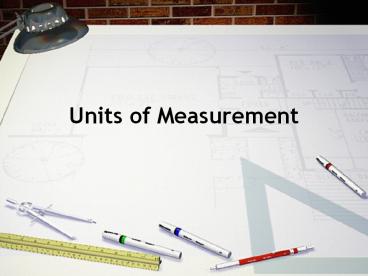Units of Measurement - PowerPoint PPT Presentation
1 / 18
Title:
Units of Measurement
Description:
... (distances between stars and galaxies Units of Measurement Distance Mass Time Area/Volume Temperature inch ... Record the ruler marking that falls at the ... – PowerPoint PPT presentation
Number of Views:966
Avg rating:3.0/5.0
Title: Units of Measurement
1
Units of Measurement
2
Why is measurement important?
- Use it in daily life
- Cooking
- Construction
- Decorating a room
- Driving
- Communication
- Need to be able to communicate measurements and
distances to other people
3
Measurement Physics
- Physicists try to find relationships between the
quantities they measure ? use units of
measurement to do this - Measure the very largest and smallest things in
the universe - Smallest mass of an electron 0.000000911 yg
- Largest light years (distances between stars
and galaxies
4
Units of Measurement
Distance Mass Time Area/Volume Temperature
inch milligram hours In2, in3 Fahrenheit
meter ounces seconds m2, m3 Celsius
mile pounds days Liters Kelvin
feet gram months Gallon
centimeter kilogram years Quart
millimeter tons minutes Pint
5
How to use a ruler
- 1. Determine if you are measuring in centimeters
or inches and find that units side of the ruler.
inches
centimeters
6
How to use a ruler
- Place the 0 mark at one end of the object you
are measuring.
0 mark
7
How to Use a Ruler
- 3. Record the ruler marking that falls at the
other end of the object
8
For Inches
- Each dash after a whole inch is 1/16 of an inch
2 3/16 in.
1 12/16 in. 1 3/4 in
1/2 in.
9
For Centimeters
- Each dash after a whole centimeter is 1/10 of an
inch
5/10 cm 0.5 cm
2 2/10 cm 2.2 cm
5.9 cm
10
Measurement Lab
11
Relative Size
Unit Relative Size Examples
Inches 1 in Photo size, body parts
Feet 1 ft 12 in Height of people, room size
Yard 1 yd 3 ft Football field
Meters 1 m 1 yd Height of people, track length
Kilometers 1km 1000m Car travels, between cities
Centimeters 1 cm 0.01 m Paper, small machine parts, body parts
Millimeters 1 mm 0.001 m Coins
12
Two Main Systems of Measurement
- United States Customary System (USCS)
- System International (SI)- Metric System
13
USCS
- Used in the U.S. and Burma
- Distance inch (in), foot (ft), yard (yd), mile
(mi) - Mass pound (lb)
- Time second (sec)
- Temperature degrees Fahrenheit (?F)
14
Metric System
- Used by all other countries and the scientific
community - Units that are larger or smaller units than the
basic units are defined in multiples of 10 - Basic Units
- Distance meter (m)
- Mass gram (g)
- Time second (s)
- Temperature degrees Celsius
- Volume Litre (L)
15
Metric System Prefixes
- Adding a prefix to a basic metric unit increases
or decreases the unit size by a factor of 10 - Prefixes are always added to the beginning of
Metric basic units - For example,
- centimeter (cm)
- milliliter (mm)
- kilogram (kg)
16
Metric Prefixes
Prefix Symbol Relation to Basic Unit
milli- m 1000 mm 1 m
centi- c 100 cm 1 m
deci- d 10 dm 1 m
deka- da 1 dam 10 m
hecto- h 1 hm 100m
kilo- k 1 km 1000 m
17
Common Unit Equivalencies
- 1 min 60 s
- 1 hr 60 min
- 1 day 24 hr.
- 1 year 365 days
- 1 m 100 cm
- 1 m 1000 mm
- 1 km 1000 m
- 1 ft. 12 in.
- 1 yd. 3 ft.
18
Conversion Factors
- Each unit equivalency can be written as TWO
conversion factors. - To make the conversion factors, place one side of
the unit equivalency on the top and the other on
the bottom of a fraction bar. - Then, flip the fraction to get the second
conversion factor.































